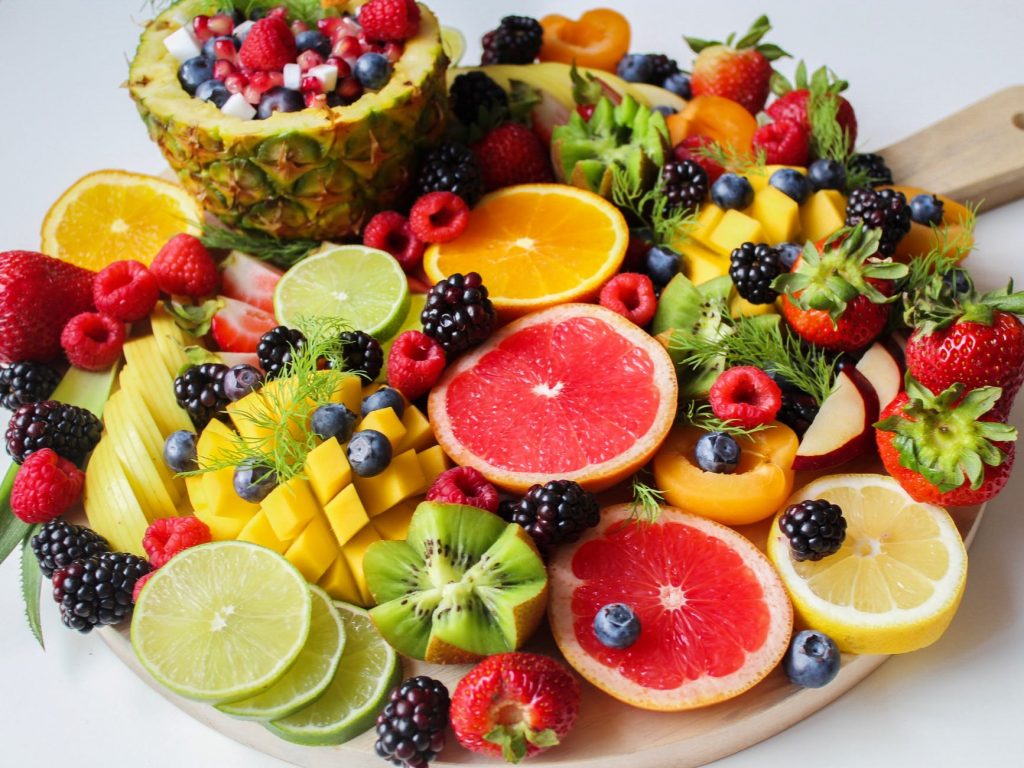Top 20 healthy fruits and vegetables for weight loss:
If you want to lose weight quickly and efficiently, you must eat a healthy diet. Vegetables and (a little bit) of fruit are the basis of a healthy diet. This article will give you my personal Top 20 of the tastiest and most healthy fruits and vegetables.
Vegetables packed with vitamins and minerals, and fruits are a healthy eater’s candy. Knowing which products from Mother Nature are the most beneficial is essential for weight loss.
Contents
Below are a few quick tips:
Eat vegetables of varying colors:
A varied diet is essential to get all the different essential nutrients. You can often tell from the color of fruits and vegetables which nutrients they contain. By eating fruits and vegetables of all different colors, you can be sure that you are getting the other nutrients.
Green is healthy:
Green vegetables generally contain the most healthy nutrients. Spinach, broccoli, kale, and Brussels sprouts are the closest we get to weight loss pills that work.
Choose seasonal fruits and vegetables:
Vegetables or fruit that have to be flown in from another part of the world often take too long and lose some nutritional value.
Always buy fruit and vegetables that are ripe:
Vegetables and fruits that are harvested and picked when ripe contain the most nutrients and are the tastiest.
My personal Top 20 healthy fruits and vegetables in no particular order:
1. Broccoli:
Broccoli is a vegetable that most people know is healthy. Yet the vegetable is not yet eaten often enough. I top the list with broccoli to urge you to eat the vegetables more often. It is merely healthy and, in the right recipe, also delicious.
Season: Broccoli is best eaten in the spring, summer, and also early autumn. In the other seasons, the price of good organic broccoli can be very high.
Nutritional value: Broccoli contains many high-quality proteins. As one of the few vegetables globally, the amino acid profile of broccoli is almost complete. All minerals and practically all vitamins (except for B12) are also present in broccoli.
Cooking Tip: Steam broccoli instead of cooking it. This way, you store more nutrients. Broccoli combines well with fish (herring is my favorite).
2. Brussels sprouts:
Brussels sprouts have a reputation as a vegetable that children (and many adults) do not like. However, this is unjustified. A good dish with Brussels sprouts can be delicious and very healthy.
Season: Brussels sprouts are best when the frost has been ‘over’ for a while. It means that the Brussels sprouts have been on the land during a frosty period. Brussels sprouts are widely available, mainly in autumn and winter.
Nutritional Value: In addition to the 86 percent water, Brussels sprouts are full of healthy nutrients. The most important are Vitamin C, Thiamin, Niacin, Vitamin A, and Vitamin K.
Cooking tip: steam Brussels sprouts for a few minutes and work them in coconut oil with onion, garlic, paprika and finally sprinkle garden herbs, pepper, and salt on top.
3. Avocado:
Avocado is the sniper of the healthy diet. You don’t hear about it often, but the avocado is full of good energy and beneficial nutrients. If you’ve never eaten an avocado before, it’s a bit tricky to peel, but once you get it, it’s a piece of cake.
Season: avocado is widely available in spring, early summer, and mid-winter.
Nutritional value: the proteins from avocado are truly phenomenal. They are of very high quality. Healthy fats are also of high quality and are present in high concentrations.
Cooking tip: in the summer, you can use avocados to give your salad some extra volume. In winter, avocado is delicious to spread over an omelet. You can use the avocado in both seasons to make delicious, fresh guacamole sauce.
4. Carrots:
Carrots are my personal favorite. They are easy to prepare, store for a long time, are cheap, and almost always have a delicious sweet taste.
Season: apart from March and April, carrots are available all year round. The price of carrots is also meager in these months.
Nutritional value: carrots are ideal as a snack because of the many dietary fibers. The dietary fiber ensures a full and satisfied feeling. Carrots are also whole of vitamin A.
Cooking tip: make carrot juice by filtering the dietary fiber from the finely ground carrots. This carrot juice contains almost all nutritional value and is an excellent alternative to highly sweetened soft drinks.
5. Sweet potatoes:
Sweet potatoes are also known as sweet potatoes. Sweet potatoes or yams are a great alternative to ‘normal’ potatoes. The sweet version contains more nutrients and is, therefore, a lot healthier.
Nutritional value: With over 700 percent of the recommended daily allowance, sweet potatoes are packed with vitamin A. Sweet potatoes are also an excellent source of essential magnesium.
Cooking tip: you can cook sweet potatoes with or without the skin. By mashing a peeled and boiled sweet potato, you can replace the potatoes in different recipes.
6. Spinach:
Popeye already knew spinach gives you muscle. Not only muscles, by the way, you also get overall better health.
Season: spinach is best eaten in the spring and summer. Then the price is the lowest, and the vegetable contains the most nutrients. An alternative for the winter months is frozen spinach.
Nutritional value: spinach is made up of 30 percent protein. It is why ‘Popeye the Sailor’ from the cartoon movie ate so much of it. Proteins help you build muscle. Spinach also has an almost complete nutritional profile. It makes spinach possibly the healthiest vegetable on this entire list.
Cooking tip: use spinach raw in salads. Cooking spinach loses a lot of nutrients. By using it raw in salads, they are preserved.
7. Onions:
Unheated onions often give off a sharp taste (and smell). Much of this sharpness comes from the many nutrients (phytonutrients) contained in onions. Eating an onion every day for breakfast, lunch, or dinner is very healthy.
Season: onions can be stored well and are therefore available all year round.
Nutritional value: onions contain decent amounts of vitamin B6, folic acid, thiamine, vitamin C, manganese, and potassium.
Cooking Tip: Most of the nutrients in the onions are on the outside. When you peel the onion, make sure you don’t strip off too many onion layers. It can result in a 75 percent drop in particular nutrients.
8. Kale:
Kale is again one of the super green vegetables. A well-known ingredient for the traditional Dutch winter stew.
Season: in autumn and winter, there is plenty of kale available.
Nutritional Value: Kale contains many Vitamin K, Vitamin A, and Vitamin C copper and manganese are also well represented in this vegetable.
Cooking tip: try making a kale stew with swede instead of potatoes. By cutting the turnip into cubes and boiling for 15 to 20 minutes, you can mash it through the (possibly raw) kale.
9. Asparagus:
The luxurious and very healthy asparagus cannot be left out of this list.
Season: both green and white asparagus are only available in the summer months of May, June, and July.
Nutritional value: an average portion of asparagus contains a superior percentage of the recommended daily amount of nutrients. Include vitamin K, folic acid, selenium, phosphorus, iron, and potassium.
Cooking tip: asparagus is often a bit too expensive to eat as a main course. However, the taste of the vegetable is delicious. It makes asparagus ideal as a side dish. Asparagus with smoked salmon is an ideal combination.
10. Cauliflower:
According to an old story, cauliflower is right for your brain. I don’t know if that is true, but I know that cauliflower is full of healthy nutrients and belongs to this Top-20 healthy fruits and vegetables list.
Season: from May to August is the cauliflower season. The price is then the lowest, and the nutritional value is usually the highest.
Nutritional value: as one of the few vegetables, cauliflower contains all the minerals. Also, it is rich in vitamins C, K, B6, and folic acid.
Cooking tip: cauliflower is delicious to eat raw. I sometimes use it as a snack or as an ‘after-dinner’ snack around nine in the evening.
11. Celery:
This fresh but strongly scented vegetable is common in dishes from Southern Europe. In the Netherlands, too, I see vegetables appearing more and more in supermarkets.
Season: from January to March and in August and September, celery is widely available.
Nutritional value: celery consists mostly of water. This water, combined with high-quality nutrients such as folic acid, vitamin K and potassium, gives you a small energy boost every time you eat it.
Cooking tip: use raw celery in your salad or add it as an ingredient in your vegetable shake.
12. Fennel:
Young mothers are often already told that fennel is good for the intestines and stomach of the baby. And this is not only true for babies. Fennel is still very healthy for fully grown people.
Season: Fennel is ripe and available fresh in stores in February and from August to November.
Nutritional value: The dietary fibers and oils in fennel help remove possible carcinogenic toxins from the intestinal wall and, therefore, help prevent colon cancer. Also, the vegetable contains a reasonable dose of folic acid, potassium, and vitamin C.
Cooking tip: Use raw fennel in vegetable smoothies so that the fiber and other nutrients can do their work correctly.
13. Garlic:
Garlic is known for the smell it leaves after you eat. Many people experience that smell as unpleasant. The scent is not negative at all. It is a sign that there are many nutrients in garlic.
Season: Garlic is available fresh all year round in most stores.
Nutritional value: garlic contains sulfur, vitamin B6, vitamin C, thiamine, manganese, selenium, calcium, and phosphorus. (eat a few cloves of garlic to get significant amounts of these nutrients).
Cooking Tips: Heating garlic can burn off a lot of nutrients. Eating garlic raw has much more effect on your health. Try making garlic juice by crushing several cloves of garlic in a blender. The taste is very intense (and the smell), but the nutrients you get are perfect and almost irreplaceable with any dietary supplement. If you do want to heat garlic for a while, let it sit for just under two minutes after you squeeze or cut it before putting it in the pan to heat. This way, the garlic retains more nutrients.
14. Red cabbage:
Red cabbage is most commonly used in hot evening meals. Steaming the vegetable improves the absorption of some nutrients in the vegetable. But red cabbage can also be finely chopped to use in salads or combination with herring.
Season: red cabbage is available fresh in stores in summer, winter, and fall. It makes the vegetable ideal for use in summer salads and winter meals.
Nutritional value: red cabbage is easy to eat in large quantities. It makes the vegetable a reasonable basis for any diet. The vegetable is filling, and one serving gives you more than 50 percent of the recommended daily allowance of vitamin C, more than 40 percent of vitamin K, and around 15 percent of vitamin A, manganese, and potassium.
Cooking tip: use the vegetables in hot meals and salads and vegetable shakes or smoothies. Both have different health benefits.
15. Apples:
In English, the saying goes: An apple a day keeps the doctor away (an apple a day keeps the doctor out). The only addition I have to this is that you have to be careful with the amount of fruit sugar that you find in an apple (just like with almost any other piece of fruit). So maybe not an apple every day, but every two or three days.
Season: except for July, apples are available all year round.
Nutritional value: the apple is certainly not at the top of this Top 20, but it is certainly healthy. Apple does not contain many nutrients but is very tasty and therefore ideal to use as a healthy candy, which makes the apple very healthy.
Eating tip: use an apple as a substitute for candy. When your snack cravings come on, eat an apple instead of anything else sweet.
16. Apricots:
Beautiful orange colored apricots are often the first signs of summer. The nutritional value of apricots is slightly similar to that of the equally orange-colored carrots.
Season: in the summer months of June, July, and August, apricots are available fresh from the Netherlands in the shop.
Nutritional value: a high dose of vitamin A and quite a bit of potassium. But above all, apricots naturally taste delicious and fresh.
Eating tip: use the apricots to sweeten your salads or dishes and omit other sweets or sweet sauces.
17. Bananas:
Banana is the healthy version of the ‘energy bar.’ Banana is one of the few natural products that can provide energy almost immediately. Ideal for sports, for example.
Season: bananas are available in stores all year round and are grown in different parts of the world.
Nutritional value: bananas have a positive effect on your intestines and elimination mechanism. For both loose stools and complicated bowel movements, it is wise to eat one banana a day.
Eating tip: use a banana at a time when you need immediate energy or to give a salad a slightly sweeter, creamy, and fresher taste.
18. Berries:
Blueberries and strawberries are the most popular berries. Several scientific studies indicate that berries can reduce and delay aging symptoms.
Season: Summer is the season of berries and strawberries. Only a few berries are also available in the fall.
Nutritional value: lots of energy in the form of fruit sugar (fructose) and many antioxidants (with the rejuvenating and anti-inflammatory effect).
Eating tip: berries are ideal for eating as a snack or giving a salad some extra flavor. Blueberries can also be used on an omelet or in oatmeal or cottage cheese.
19. Oranges:
Oranges are ideal for making your vegetable shake taste better. Make sure you don’t filter out the fibers. The dietary fiber ensures that the sugar from the fruit is not absorbed into your blood too quickly.
Season: oranges are available all year round.
Nutritional Value: Oranges are packed with vitamin C.
Eating tip: produced and filtered orange juice (as available in many supermarkets) is not the same as whole oranges. The sugar from orange juice is absorbed into your blood faster with all its unpleasant consequences. It also applies to ‘fresh’ squeezed orange juice from which the dietary fiber has been filtered.
20. Grapefruit:
Grapefruits are known for their bitter taste. And therefore often not popular with children. Because many people did not eat this fruit as a child, it is not usually added to the diet when one is a bit older. However, this doesn’t seem right because the fruit is very healthy, and the bitter taste is not that bad.
Season: Grapefruits are available from January to May.
Nutritional value: Like the orange, grapefruit is a citrus fruit and, therefore, contains many vitamin C. Red grapefruits are best as they also have the potent antioxidant lycopene.
Eating tip: grapefruit is ideal for making desserts. This way, you get a nice looking and tasty dish without it containing a lot of sugar.





Pingback: Why It's Important to Wash Your Fruits and Vegetables Before Consuming.